动词的被动语态
动词被动语态
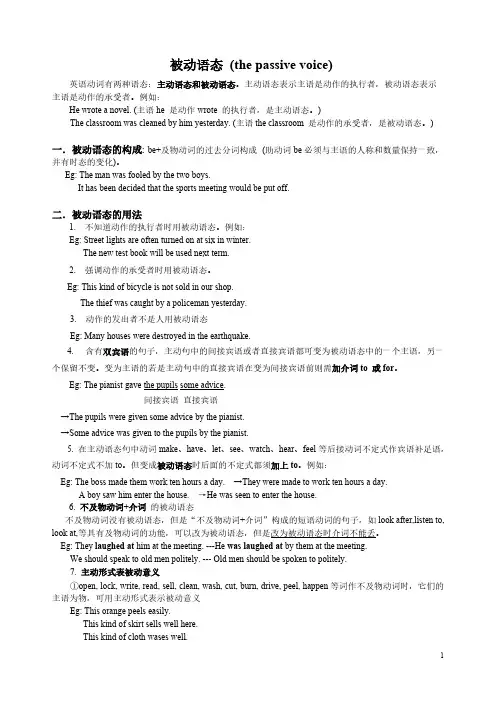
被动语态(the passive voice)英语动词有两种语态:主动语态和被动语态。
主动语态表示主语是动作的执行者,被动语态表示主语是动作的承受者。
例如:He wrote a novel. (主语he 是动作wrote 的执行者,是主动语态。
)The classroom was cleaned by him yesterday. (主语the classroom 是动作的承受者,是被动语态。
)一.被动语态的构成: be+及物动词的过去分词构成(助动词be必须与主语的人称和数量保持一致,并有时态的变化)。
Eg: The man was fooled by the two boys.It has been decided that the sports meeting would be put off.二.被动语态的用法1. 不知道动作的执行者时用被动语态。
例如:Eg: Street lights are often turned on at six in winter.The new test book will be used next term.2. 强调动作的承受者时用被动语态。
Eg: This kind of bicycle is not sold in our shop.The thief was caught by a policeman yesterday.3.动作的发出者不是人用被动语态Eg: Many houses were destroyed in the earthquake.4. 含有双宾语的句子,主动句中的间接宾语或者直接宾语都可变为被动语态中的一个主语,另一个保留不变。
变为主语的若是主动句中的直接宾语在变为间接宾语前则需加介词to 或for。
Eg: The pianist gave the pupils some advice.间接宾语直接宾语→The pupils were given some advice by the pianist.→Some advice was given to the pupils by the pianist.5. 在主动语态句中动词make、have、let、see、watch、hear、feel等后接动词不定式作宾语补足语,动词不定式不加to。
动词的被动语态
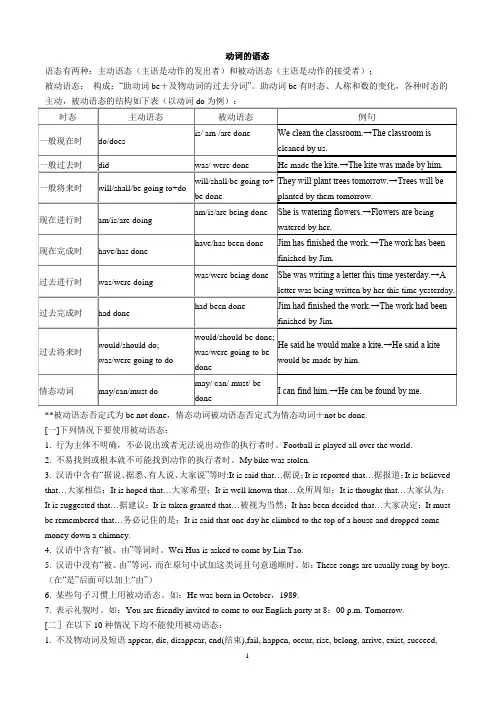
动词的语态语态有两种:主动语态(主语是动作的发出者)和被动语态(主语是动作的接受者);被动语态:构成:“助动词be+及物动词的过去分词”。
助动词be有时态、人称和数的变化,各种时态的主动,被动语态的结构如下表(以动词do为例):时态主动语态被动语态例句一般现在时do/does is/ am /are done We clean the classroom.→The classroom iscleaned by us.一般过去时did was/ were done He made the kite.→The kite was made by him.一般将来时will/shall/be going to+do will/shall/be going to+be doneThey will plant trees tomorrow.→Trees will beplanted by them tomorrow.现在进行时am/is/are doing am/is/are being done She is watering flowers.→Flowers are b eingwatered by her.现在完成时have/has done have/has been done Jim has finished the work.→The work has beenfinished by Jim.过去进行时was/were doing was/were being done She was writing a letter this time yesterday.→Aletter was being written by her this time yesterday.过去完成时had done had been done Jim had finished the work.→The work had beenfinished by Jim.过去将来时would/should do;was/were going to dowould/should be done;was/were going to bedoneHe said he would make a kite.→He said a kitewould be made by him.情态动词may/can/must do may/ can/ must/ bedoneI can find him.→He can be found by me.**被动语态否定式为be not done,情态动词被动语态否定式为情态动词+not be done.[一]下列情况下要使用被动语态:1. 行为主体不明确,不必说出或者无法说出动作的执行者时。
动词的被动语态
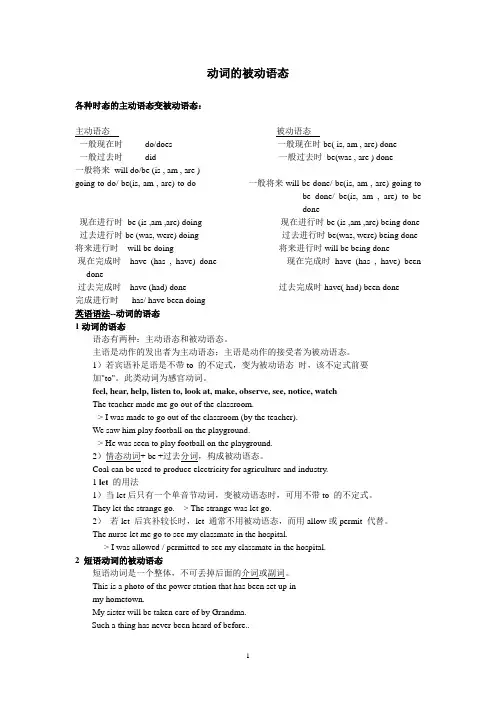
动词的被动语态各种时态的主动语态变被动语态:主动语态被动语态一般现在时do/does 一般现在时be( is, am , are) done一般过去时did 一般过去时be(was , are ) done一般将来will do/be (is , am , are )going to do/ be(is, am , are) to do 一般将来will be done/ be(is, am , are) going tobe done/ be(is, am , are) to bedone现在进行时be (is ,am ,are) doing 现在进行时be (is ,am ,are) being done 过去进行时be (was, were) doing 过去进行时be(was, were) being done 将来进行时will be doing 将来进行时will be being done现在完成时have (has , have) done 现在完成时have (has , have) been done过去完成时have (had) done 过去完成时have( had) been done完成进行时has/ have been doing英语语法--动词的语态1动词的语态语态有两种:主动语态和被动语态。
主语是动作的发出者为主动语态;主语是动作的接受者为被动语态。
1)若宾语补足语是不带to 的不定式,变为被动语态时,该不定式前要加"to"。
此类动词为感官动词。
feel, hear, help, listen to, look at, make, observe, see, notice, watchThe teacher made me go out of the classroom.--> I was made to go out of the classroom (by the teacher).We saw him play football on the playground.--> He was seen to play football on the playground.2)情态动词+ be +过去分词,构成被动语态。
动词的被动语态
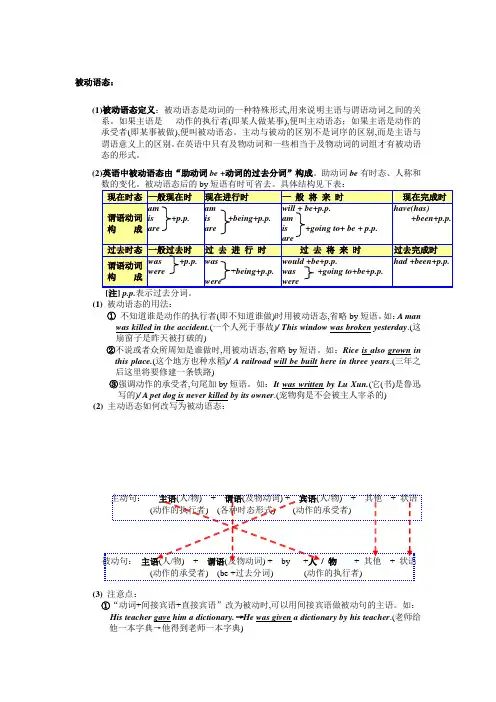
被动语态:(1)被动语态定义:被动语态是动词的一种特殊形式,用来说明主语与谓语动词之间的关系。
如果主语是动作的执行者(即某人做某事),便叫主动语态;如果主语是动作的承受者(即某事被做),便叫被动语态。
主动与被动的区别不是词序的区别,而是主语与谓语意义上的区别。
在英语中只有及物动词和一些相当于及物动词的词组才有被动语态的形式。
(2)英语中被动语态由“助动词be +动词的过去分词”构成。
助动词be有时态、人称和(1) 被动语态的用法:①不知道谁是动作的执行者(即不知道谁做)时用被动语态,省略by短语。
如:A manwas killed in the accident.(一个人死于事故)/ This window was broken yesterday.(这扇窗子是昨天被打破的)②不说或者众所周知是谁做时,用被动语态,省略by短语。
如:Rice is also grown inthis place.(这个地方也种水稻)/ A railroad will be built here in three years.(三年之后这里将要修建一条铁路)③强调动作的承受者,句尾加by短语。
如:It was written by Lu Xun.(它(书)是鲁迅写的)/ A pet dog is never killed by its owner.(宠物狗是不会被主人宰杀的)(2)主动语态如何改写为被动语态:(3) 注意点:①“动词+间接宾语+直接宾语”改为被动时,可以用间接宾语做被动句的主语。
如:His teacher gave him a dictionary.→He was given a dictionary by his teacher.(老师给他一本字典→他得到老师一本字典)也可以用直接宾语做被动句的主语,但是需用to或者for引出原句的间接宾语。
如:His teacher gave him a dictionary.→A dictionary was given to.. him by his teacher.(老师给他一本字典→一本字典由老师送给了他)/His father made him a kite.→A kite was made for...him by his father.(他的父亲给他做了一个风筝→一个风筝由他的父亲做给了他)②“动词+宾语+动词原形”改为被动时,动词原形前要加to.如:The boss made the poor man work 12 hours a day.→The poor man was made to.. work 12 hours a day.(老板让这个可怜的人一天工作12小时→这个可怜人被迫一天工作12小时)③“动词+…+介词”改为被动时,介词一般在原位不动。
动词的被动语态
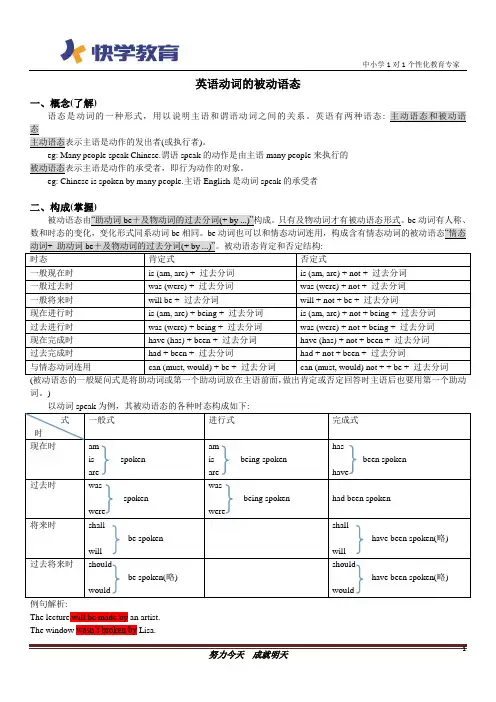
英语动词的被动语态一、概念(了解)语态是动词的一种形式,用以说明主语和谓语动词之间的关系。
英语有两种语态:(或执行者)。
speak的动作是由主语many people来执行的eg: Many people speak Chinese.谓语二、构成(掌握)(被动语态的一般疑问式是将助动词或第一个助动词放在主语前面,做出肯定或否定回答时主语后也要用第一个助动词。
)例句解析:The lecture will be made by an artist.The window wasn’t broken by Lisa.Is Mars now being explored by scientists?--Yes, it is. / No, it isn’t.What was stolen last night?When was the school football team set up?Such work can be done in an hour.These books mustn’t be taken out of the reading room.Must the work be handed in by tomorrow?--Yes, it must be. / No, it needn’t be.When can my computer be repaired?What can be reused?三、用法(了解)一般来说,在我们日常生活中,能用主动语态的时候就尽量不去用被动语态。
只有在下列情况中我们才用被动语态:1.不知道动作的执行者是谁。
eg: 1).Some new computers were stolen last night.一些新电脑在昨晚被盗了。
2).This bridge was founded in 1981.这座桥竣工于1981年。
3).The front window in the classroom was broken yesterday. 昨天,教室的前窗被打破。
英语中的被动语态
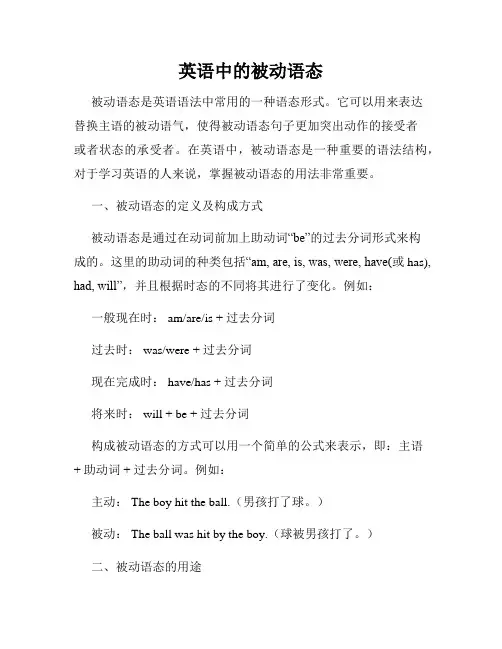
英语中的被动语态被动语态是英语语法中常用的一种语态形式。
它可以用来表达替换主语的被动语气,使得被动语态句子更加突出动作的接受者或者状态的承受者。
在英语中,被动语态是一种重要的语法结构,对于学习英语的人来说,掌握被动语态的用法非常重要。
一、被动语态的定义及构成方式被动语态是通过在动词前加上助动词“be”的过去分词形式来构成的。
这里的助动词的种类包括“am, are, is, was, were, have(或has), had, will”,并且根据时态的不同将其进行了变化。
例如:一般现在时: am/are/is + 过去分词过去时: was/were + 过去分词现在完成时: have/has + 过去分词将来时: will + be + 过去分词构成被动语态的方式可以用一个简单的公式来表示,即:主语+ 助动词 + 过去分词。
例如:主动: The boy hit the ball.(男孩打了球。
)被动: The ball was hit by the boy.(球被男孩打了。
)二、被动语态的用途1、突出动作的承受者或者状态的承受者被动语态的最主要的用途就是通过替换主语来打出动作的承受者或状态的承受者的差异。
例如:主动: My father bought a new car yesterday.(我爸爸昨天买了一辆新车。
)被动: A new car was bought by my father yesterday.(昨天一辆新车被我爸爸买了。
)2、避免使用主语如果某些情况下,使用主语会使得句子过于重复或者语法不对,那就可以使用被动语态来代替主语。
例如:主动: People say that he is the best student in our school.(人们说他是我们学校最好的学生。
)被动: It is said that he is the best student in our school.(据说他是我们学校最好的学生。
动词的被动语态
被动语态英语动词有两种语态:主动语态和被动语态主动语态表示主语是谓语动词动作的执行者,被动语态表示主语是谓语动词动作的承受者。
在被动结构的句子中,动作的执行者可以由介词by引起的短语表示。
Everyone respects him.He is respected by everyone.被动语态的构成:助动词be +done(时态通过be表现出来)一.各种时态常见的被动语态形式1.一般现在时(am/is/are + done) 如:Y ou are wanted on the phone. 有电话找你。
【例】:In some parts of the world, tea _____ with milk and sugar.A. is servingB. is servedC. servesD. servedThe number of deaths from heart disease will be reduced greatly if people ______ to eat more fruit and vegetables.A. persuadeB. will persuadeC. be persuadedD. are persuaded2.一般过去时(was/were+ done) 如:The city was liberated in 1949. 这座城市是1949年解放的。
【例】:I _____ ten minutes to decide whether I should reject the offer.A. gaveB. was givenC. was givingD. had given3.一般将来时(will be done) 如:They will be invited to your party. 他们将被邀请参加你的晚会。
【例】:Hundreds of jobs _____ if the factory closes.A. loseB. will be lostC. lostD. will lose4.现在进行时(am/is/are+ being done) 如:The car is being repaired. 车在修理当中。
动词的被动语态
被动语态:be/get + done英语中被动语态常用于下列几种场合:不知道动作的执行者;不必提到动作的执行者;强调或侧重动作的承受者分析下面的例句,注意被动语态的用法1.The window was broken.2.It is suggested that we put the meeting off.3.The boy got bitten by a dog.4.All that can be done has been done.5.The thief is being chased by the policemen.即时检验1. After school we went to the reading-room to do some reading, only to be told that it ________ .A. was decoratedB. had decoratedC. had been decoratingD. was being decorated2. --Have you heard about that fire in the market?--Yes, fortunately no one _____.A. hurtB. was hurtC. has hurtD. had been hurt3. They are living with their parents for the moment because their own house ____.A. is being rebuiltB. has been rebuiltC. is rebuiltD. has rebuilt4. Mum, I was wondering if you could lend me a few dollars until I ____ on Friday.A. get paidB. got paidC. have paidD. had been paid 疑难解释:不用被动的情况⏹不及物动词及一些相当于不及物动词的固定短语不能用被动语态,常见的有:happen, occur, take place, belong to, break out, run out, give out, go out, come out等例:The accident happened last week.⏹表示状态特征的连系动词如smell, taste, feel, sound, look,prove等不用被动语态(用主动语态表示被动意义)例:In the end our theory proved right.⏹want, require, need或deserve(“应受,应得”)后面接动名词,为主动形式表示被动意义。
8种时态的被动语态
动词的语态:主动语态和被动语态被动语态的基本结构:Be + done(过去分词)1、一般现在时:(主动语态)I help you.发出者动词承受者变为被动语态:Do——am/is/are doneYou are helped by me.承受者谓语发出者2、一般过去时的被动:did——was/were done(I helped you.-每个例子可让学生自己先尝试变被动,再给答案)3、一般将来时的被动:Will do——will be done(I will help you.-)4、现在进行时的被动:Am/is/are doing ——Am/is/are being done(I am helping you.-)5、过去进行时的被动:Was/were doing——Was/were being done(I was helping you.-)6、现在完成时的被动:Have done——have been done (I have helped you.-)7、过去完成时的被动:Had done——had been done (I had helped you.-)8、过去将来时的被动:Would do ——would be done (I would help you.-)答案:2、You were helped by me.3、You will be helped by me.4、You are being helped by me.5、You were being helped by me.6、You have been helped by me.7、You had been helped by me.8、You would be helped by me.。
动词的被动语态
动词的被动语态一、知识体系被动语态:语态是动词的一种形式,它表示主语和谓语的关系。
语态有两种:主动语态和被动语态。
如果主语是动作的执行者,或者是说动作是由主语完成的,要用主动语态;如果主语是动作的承受者,或者是说动作不是由主语而是由其他人完成的,则用被动语态。
基本结构:be+动词的过去分词各种时态,句型的主动被动语态结构表二、考点归纳(一)近五年天津中考试题共涉及10道相关题目单选题7道(9.3%),完成句子1道(4%),综合填空2道(4%)一般现在时:0541 0884 0941一般过去时:0733 0683 0770 0839一般将来时:0736情态动词:0540 0787(二)考查重点1、动词各种时态的被动语态形式以及主动形式表示被动意义的结构。
2、被动语态的结构和表达的意义。
3、被动语态的一些特殊运用形式。
(三)考查难点1、情态动词的被动语态结构。
2、主动表被动含义。
3、主动语态与被动语态的区别与联系。
(四)相关考点1、情态动词must的被动语态。
2、被动语态的各种时态对比。
3、被动语态的使用情境。
三、知识清单(一)适合被动语态的情况a.不知道谁是动作的执行者,或由于某种原因没有必要指出谁是动作的执行者时。
例如:This jacket is made of cotton. The book was written for children. 真题再现:0540.The flowers________ every day. Or they’ll die.A must waterB can be wateredC should waterD must be watered 0541.We are often told______ at people in trouble.A not to smileB to smileC not to laughD to laughb.需要突出或强调动作的承受者,例如:Food is needed by every living thing. 真题再现:0683. A short time ago,a test w(83)given in the United States. was0787. Computers can be u (87) for much more than word processing used (二)主动语态和被动语态的转换1)主动语态改被动语态的方法a)将主动语态改为被动语态应注意以下三个方面:①将主动语态的宾语改为被动语态的主语;②将主动语态的谓语动词改为“be+过去分词”结构;③将主动语态的主语改为介词by之后的宾语,放在谓语动词之后(有时可省略)。
- 1、下载文档前请自行甄别文档内容的完整性,平台不提供额外的编辑、内容补充、找答案等附加服务。
- 2、"仅部分预览"的文档,不可在线预览部分如存在完整性等问题,可反馈申请退款(可完整预览的文档不适用该条件!)。
- 3、如文档侵犯您的权益,请联系客服反馈,我们会尽快为您处理(人工客服工作时间:9:00-18:30)。
动词的被动语态考点一:被动语态的构成及用法词的被动语态英语语态有主动语态和被动语态两种。
主语是动作的执行者,叫做主动语态;主语是动作的承受者,叫做被动语态。
例如: We swept the floor. 我们打扫了地板。
(主动语态)The floor was swept. 地板被打扫过。
(被动语态)1.被动语态的构成(1) 被动语态是由“be+及物动词的过去分词”构成的。
be有人称,数和时态的变化,其变化规则与其作为连系动词的be的变化完全一样。
a被动语态的肯定句 Apple trees are planted in the south. 苹果树种在南方。
b被动语态的否定句 The building hasn't been completed. 这座建筑物没有竣工。
c被动语态的一般疑问句被动语态的一般疑问句的结构是:Be+主语+过去分词(vt)+(by+宾语)Are they made in China? Yes, they are.Was the museum built in 1993? No, it was built in 1986.d 被动语态的特殊疑问句被动语态的特殊疑问句的结构是:疑问词+be+主语+过去分词(vt)。
What is the machine used for? It is used for making paper.Where were the car made? They were made in China.(2) 被动语态的几种时态形式:a.一般现在时结构:主语+ am / is / are + 过去分词主动句:She cleans her room every day.被动句:Her room is cleaned (by her) every day. (肯定句)否定句:Her room isn’t cleaned (by her) every day.一般疑问句:Is her room cleaned (by her) every day?注意:被动句的be助动词的变化应按被动句中新主语的人称和数而变化,其时态应与主动句的时态一致.b.一般过去时结构:主语+was / were +过去分词主动句:The workers made the VCD last week.被动句:The VCD was made by the workers last week.(肯定句)否定句: The VCD wasn’t made by the workers last week.一般疑问句:Was the VCD made by the workers last week?c. 一般将来时结构:主语+will be + 过去分词主动句:My father will send me to America soon.肯定句:I will be sent to America by my father soon.否定句:I won’t be sent to America by my father soon.一般疑问句:Will you be sent to America by your father soon?d. 过去将来时结构:主语+would be + 过去分词主动句:He said he would punish the naughty boy tonight.肯定句:He said the naughty boy would be punished by him tonight.否定句:He said the naughty boy wouldn’t be punished by him tonight.e. 现在进行时结构:主语+ am / is / are + being + 过去分词主动句:He is telling a story now.肯定句:A story is being told by him now.否定句:A story isn’t being told by him now.一般疑问句:Is a story being told by him now?f. 过去进行时结构:主语+was / were + being + 过去分词主动句:He was telling a story when I came in.肯定句:A story was being told by him when I came in.否定句:A story wasn’t being told by him when I came in.一般疑问句:Was a story being told by him when I came in?g. 现在完成时结构:主语+have / has +been + 过去分词主动句: The boy has finished the work.肯定句: The work has been finished by the boy.否定句: The work hasn’t been finished by the boy.一般疑问句: Has the work been finished by the boy?h. 过去完成时结构:主语 + had + been + 过去分词主动句: They had built ten buildings by 2003.肯定句: Ten buildings had been built by them by 2003.否定句: Ten buildings hadn’t been built by them by 2003.一般疑问句: Had ten buildings been built by them by 2003?i. 含有情态动词结构:主语+can/may/must+be+过去分词主动句: I can find it.肯定句: It can be found by me.否定句: It can’t be found by me.一般疑问句: Can it be found by me?2.被动语态的用法(1) 不知道动作的执行者是谁。
English is taught in all middle schools. 所有中学都开设英语课。
(2) 没有必要指出动作的执行者是谁。
The meeting was held last week. 会议上周召开了。
(3) 要强调动作的承受者而不是执行者时。
Teapots are used for drinking. 茶壶是饮水用的。
3.被动语态中应注意的几个问题(1) 在被动语态句子中要注意主语与谓语在人称和数方面要保持一致。
(2) 主动语态不能变为被动语态的情况:a.have(有)以及和have构成的短语动词不能用于被动语态b.不及物动词没有动作的承受者,不能用被动语态。
c.主动句的宾语是each other或反身代词时,不能变成被动句的主语。
d.主动句的宾语是不定式或动词的-ing形式时,不能变成被动句的主语。
(3) 注意有时用主动语态表示被动意义的情况。
例如: This kind of cloth washes very well. 这种布很禁洗。
The machine made in China sell well abroad. 中国制造的机器在国外畅销4.被动语态和系表结构的区别动词“be+过去分词”这一结构既可以是被动语态,也可以是系表结构。
这两种结构主要的区别是:被动语态强调动作,系表结构强调状态。
我们还可以通过以下方法来判断:(1) 从形式上来看,被动语态往往接by施动者,而系表结构往往有固定的搭配。
如:be joined to, be connected with, be separated from, be covered with, be interested in, be surprised at, be satisfied with, be concerned about等。
We were surprised at the unexpected news. 听到这个意外消息,我们感到惊讶。
(系表结构)注意:句中有“by+人”时,多用被动语态;而“by+物”时,多属系表结构。
如:The house was surrounded by the police. 这房子被警察包围了。
(被动语态) The house was surrounded by trees. 这房子四周都是树。
(系表结构,表示静止的状态) (2) 从时态上来看,被动语态的be时态要与动作发生的时间一致;而系表结构的be只有一般时或完成时,表示目前或过去的性质或状态。
如:This window was broken by Kate yesterday这窗户是凯特昨天打破的。
(被动语态) This glass is broken. 这块玻璃是破的。
(系表结构,指目前的状态)(3)从句中的状语来看,过去分词前有well, very, quite等副词修饰的是系表结构;若句中有时间、方式或目的状语时,一般为被动语态。
The play is well written. 这剧本写得很好。
(系表结构)The play was written with great care. 这剧本是非常用心地写出来的。
(被动语态,有方式状语) (4)被动语态中的过去分词必须是及物动词,而系表结构中的过去分词可以是gone, fallen, risen 等不及动词。
如下列两句是系表结构:My pen is gone. 我的钢笔不见了。
The sun is risen. 太阳升起来了。
In-Class Exercises1. Good books ____ again and again.A. should be readedB. should be readC. must readD. ought to read2. The children ____ by the nurse.A. were lookedB. looked afterC. were looked afterD. looked3. He ___ some pieces of advice, but he ____ to them.A. gave, didn't listenB. was given, wasn't listenedC. give, wasn't listenedD. was given, didn't listen4. When____ the accident _____ ?A. was, happenB. did, happenC. is, happenD. was, happened5. The question ____ by us soon.A. is going to discussB. will discussC. is going to be discussedD. has been discussed6. The lab ____ about five years ago.A. was buildedB. was builtC. buildsD. has been built7. A lot of tall buildings _____ in his hometown in the last three years.A. have set upB. have been set upC. were set upD. set up8. They ____ printing 500 copies by the end of last month.A. had finishedB. have finishedC. had been finishedD. have been finished9. Rice ___ also _____ in their hometown.A. is…grownB. is…grewC. was…grewD. was…grown10. He ____ by the teachers.A. is always praisedB. praisesC. have been praisedD. always is praised考点二:主动语态和被动语态的转换1.主动语态变为被动语态的方法(1) 将主动句里的宾语成分变为被动句里的主语成分。
